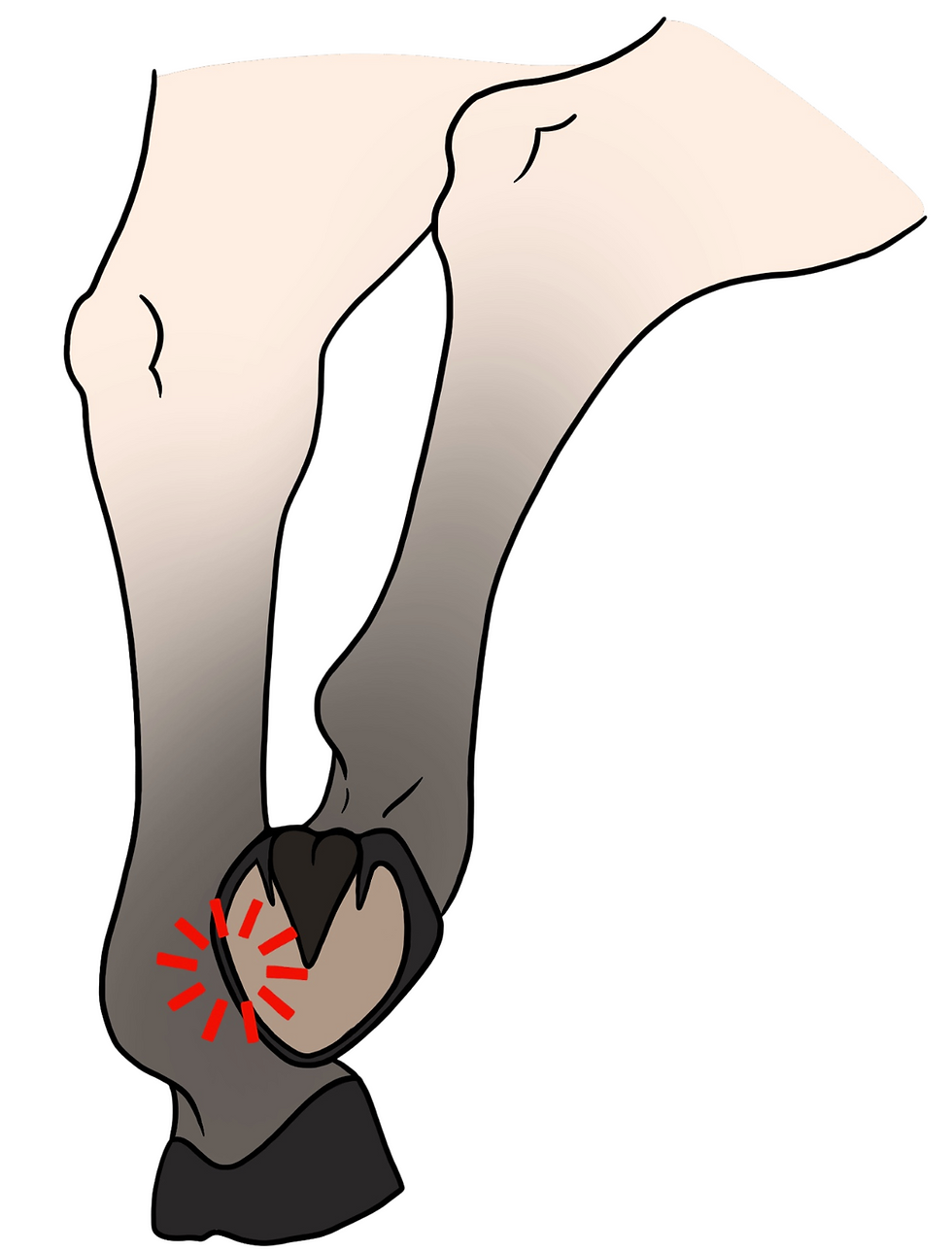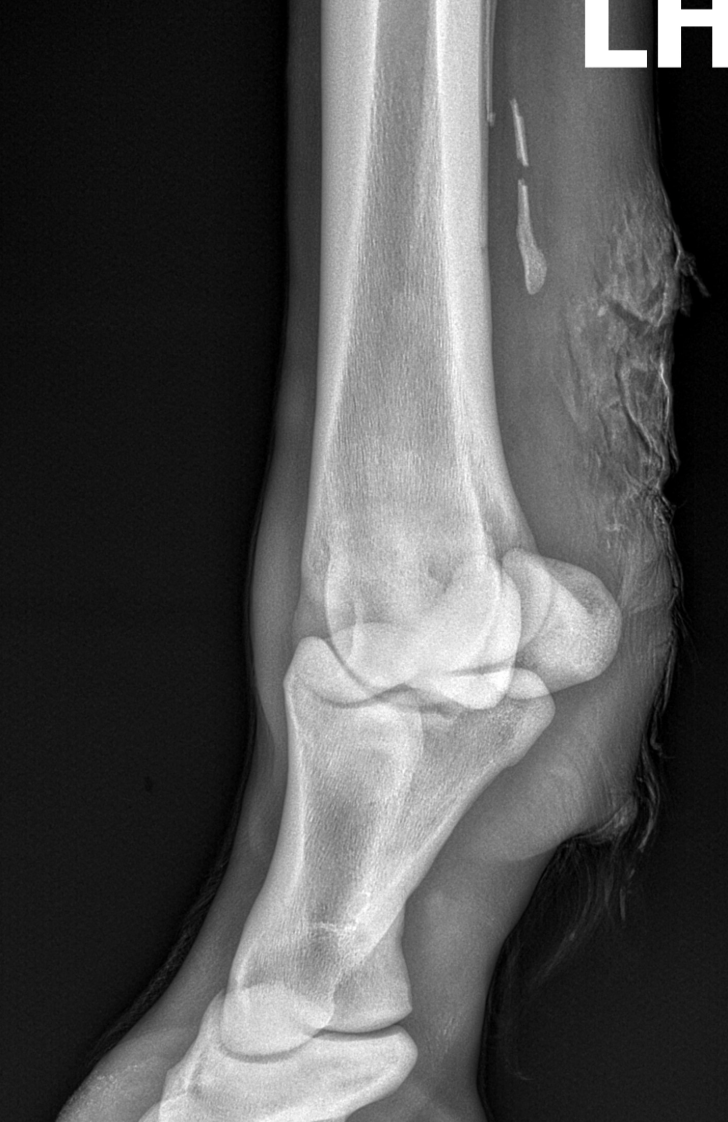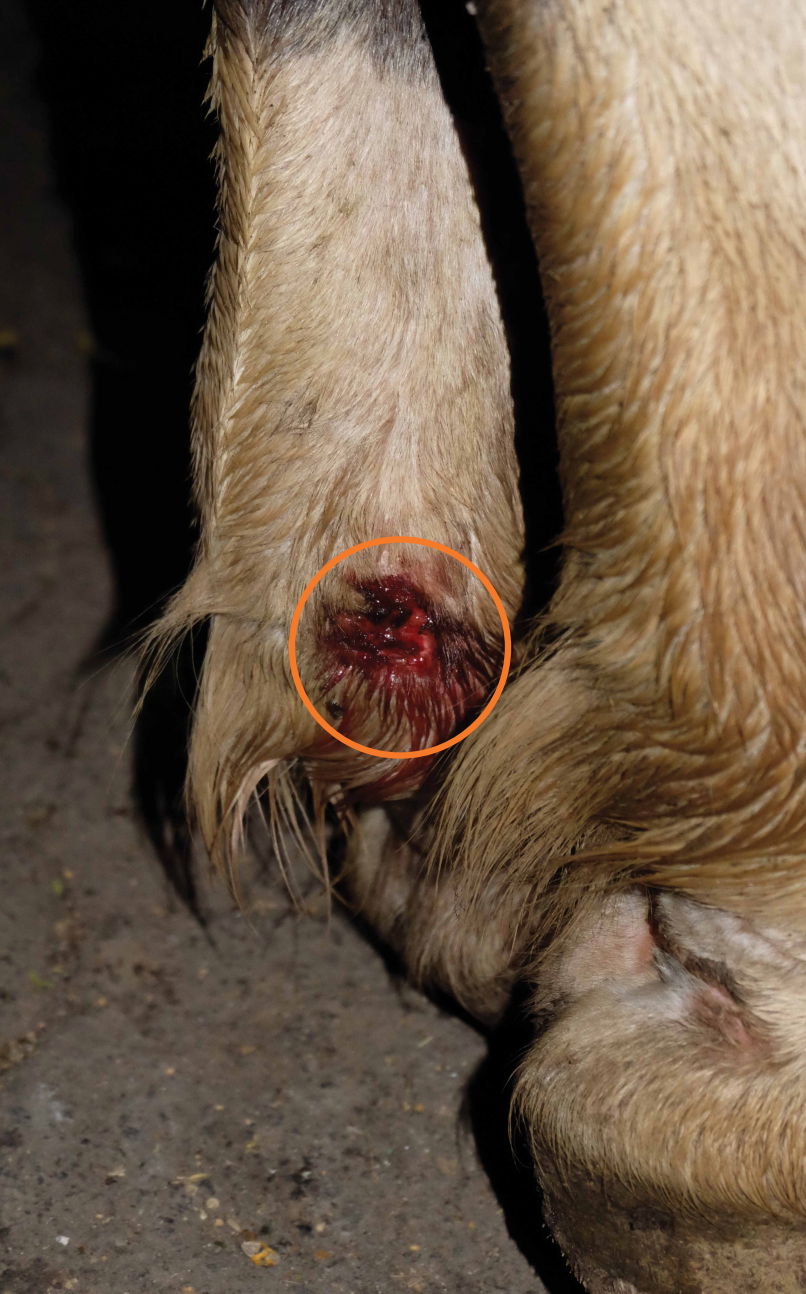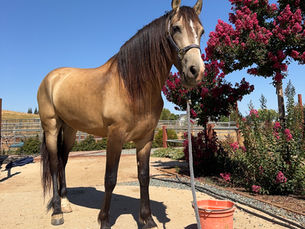Gait Faults: Interfering
- Horse Education Online

- Jul 28
- 9 min read
Updated: Jul 29
Interfering is major gait fault observed in horses, where one limb strikes the opposite limb during motion. Although often minor, it can lead to performance issues, and in some cases, injury. This article explores the phenomenon of interfering, distinguishing between front limb interfering and hind limb interfering, identifying underlying causes, and discussing practical management strategies.
It is important to understand that this is a serious gait fault that must be addressed by protecting the affected limbs and trimming and shoeing to minimize incidence.
If you are unfamiliar with gait faults, make sure you read our foundational knowledge article on the topic - Understanding Gait Faults in Horses: A Practical, In-Depth Guide.
Front Limb Interfering

Definition
Front limb interfering occurs when the medial (inner) portion of one front foot strikes the medial side of the opposite front foot, leg, or knee. The degree of contact can vary:
Brushing: Light, superficial contact without injury.
True Interfering: Heavier contact that may cause bruising or injury, particularly in fast work or on unstable terrain.
Conformational Causes
Conformation is the primary contributing factor. Horses that are:
Base narrow
Toed out
Narrow in the chest
...are more likely to wing inward during the swing phase of the stride. This inward movement increases the probability of the limb crossing the midline and striking the opposite limb.
To learn more about how conformation influences movement, and how particular conformation faults may lead to faults of gait, take our Equine Conformation Certification program, or download our Equine Conformation Study Flashcards.
Additional contributors include:
Fatigue
Growth stages in young horses
Irregular terrain
Poor rider balance
Environmental and Situational Triggers
Even horses without conformational faults may interfere when:
Ridden on uneven or slippery ground
Carrying a poorly balanced rider
Under stress or exerting effort at speed (e.g., during jumping or fast turns)
Management and Prevention
Trimming and Shoeing:
Routine shoeing should be maintained for balance, but there should be no special trimming for occasional interfering.
Remedial shoeing may be employed for chronic cases where the horse is injuring himself. By using weight and traction placement, the movement of the limb can be influenced as the horse moves at higher speeds.
For example, placing more traction on the lateral branch of the shoe can encourage the foot to swing outward slightly.
Remember: Horses’ feet tend to move toward weight and traction—but only at speed. It will be extremely difficult to correct any gait fault that occurs as the horse is walking.
Protective Gear:
Interference boots, splint boots or brushing boots can help minimize the risk of trauma in performance horses.

Protective Boots Training and Terrain:
Training on flat, even ground
Improving rider stability and posture
Conditioning work to develop muscle balance
Hind Limb Interfering

Definition
Hind limb interfering is the instance where the medial side of a hind foot (or its shoe) strikes the opposite hind limb, typically targeting the fetlock joint. Like in the forelimbs, this contact can range from brushing to more impactful blows, depending on gait, speed, and terrain.
Conformational and Biomechanical Causes
Much like front limb interfering, conformation plays a major role. Horses that are:
Base narrow behind
Toed out behind
Narrow through the hindquarters
...will naturally wing inward during movement, particularly in the swing phase of the gait, resulting in medial interference.
To learn more about how conformation influences movement, and how certain conformation faults may lead to faults of gait, take our Equine Conformation Certification program, or download our Equine Conformation Study Flashcards.
Additional influences:
Hock or stifle soreness altering stride pattern
Weak hind limb musculature
Loss of proprioception in older or neurologically compromised horses
Managing Hind Limb Interfering
Shoeing Approaches:
Square-toed shoes can assist by adjusting breakover timing, improving the swing trajectory of the hind limb.

Square toe shoe by Casey Stribling, CJF As in the front limbs, weight and traction can be strategically altered to influence limb flight.
Applying weight or traction on the lateral heel may help shift the trajectory outward.

Lateral weight/traction shoe by Joe Novy, CJF
Trimming:
Maintaining balance is critical.
Avoid over-corrective trimming unless under veterinary or farriery guidance, as improper trimming can exacerbate the problem.
Physical Conditioning:
Hindquarter strength-building exercises (e.g., hill work, poles, lateral work) improve muscular support and limb control.
Therapeutic Intervention:
In cases of neurological or orthopedic origin, proper diagnosis and treatment plans must be developed in coordination with a veterinarian.
A deeper knowledge of musculoskeletal anatomy can help identify how joint pain alters limb flight. Learn more in our Equine Anatomy Certification.
When Interfering Becomes a Serious Issue
While mild interfering—particularly brushing—may seem like a cosmetic or minor inconvenience, repeated or forceful interfering can evolve into a clinically significant condition. Any amount of interfering is to be considered a major gait fault and should be addressed as such. When the contact between limbs intensifies due to poor conformation, fatigue, or poor riding conditions, it may lead to lasting injury.
Injury Risks from Chronic or Severe Interfering
Splints (Interosseous Desmitis and Periostitis)

A splint will present itself as a bump on the cannon/splint bone area. Repeated blunt trauma from a striking limb can cause inflammation of the interosseous ligament or periosteum (the bone’s outer layer) along the splint bones, especially the medial side.
This condition, commonly known as a splint, manifests as localized swelling, heat, and pain, and in some cases leads to ossification between the splint bone and the cannon bone.
These injuries can lead to persistent lameness and performance limitations, especially in disciplines requiring agility and speed.
Because chronic interfering can lead to lasting soundness issues, it’s important to differentiate between gait-related injuries and true lameness. For a step-by-step approach, see our Comprehensive Guide to Equine Lameness.
Fracture of the Splint Bone Nodule (Distal End)

Radiographic evidence of splint bone nodule fracture The distal (lower) nodule of the splint bone, particularly on the medial aspect, is a common site for direct interference impact.
Forceful, repetitive blows can cause stress fractures or even acute fractures in this region.
Such injuries often require long rest periods, and in some cases, surgical removal of the distal splint bone fragment (ostectomy).
Fetlock Lacerations or Abrasions (Hind Limb)

Laceration of the medial aspect of the fetlock In hind limb interference, especially during fast work or jumping, a strong medial blow can abrade or lacerate the fetlock joint of the opposite limb.
These injuries are prone to infection and can become chronic if not managed promptly.
Joint Capsule or Tendon Sheath Trauma
Severe impact in either the forelimb or hindlimb can traumatize sensitive structures like joint capsules or digital tendon sheaths.
Resulting inflammation can mimic synovitis or tenosynovitis, leading to swelling, pain, and reduced range of motion.
Factors That Exacerbate Injury Potential
Speed: Faster gaits increase the energy and force of the swing phase, magnifying the impact severity.
Shoeing: Shoes with medial trailers, studs, or hard edges can amplify trauma if interference occurs. "Preventer" shoes are often used to ensure a shoeing package does not become a weapon the horse can further strike itself with. In a preventer shoe, the medial side is thinned out, and occasionally the hoof is allowed to hang beyond the perimeter of the shoe. While this type of shoe does not "fix" the fault of gait, it reduces the risk of serious injury.

Preventer barshoe by Kyle Marney, CF Terrain and Footing: Uneven or deep footing disrupts stride stability and increases chances of crossing limbs.
Fatigue or Weakness: Tired muscles are less able to coordinate and stabilize limb flight, resulting in sloppy or erratic movement patterns.
Preventive Strategies for Injury-Prone Horses
Protective Equipment: Regular use of brushing boots, fetlock guards, or interference boots is essential for horses with a history of moderate to severe interfering.
Targeted Shoeing: Skilled farriery focusing on breakover timing, limb flight adjustment, and lateral support can reduce damaging contact.
Veterinary Imaging and Monitoring: Recurrent interfering injuries should be investigated via ultrasound or radiographs to rule out splint bone involvement or tendon damage.
Rest and Rehabilitation: Acute injuries caused by interfering should be treated promptly with rest, anti-inflammatory management, and controlled exercise to prevent chronic scarring or lameness.
FAQ About Gait Faults: Interfering
What causes front limb interfering in horses?
Front limb interfering is commonly caused by conformational faults such as:
Base-narrow stance
Toed-out hooves
Narrow chest width
These conformations lead to inward winging of the limbs during the swing phase, increasing the chance of striking the opposite leg. Uneven terrain, speed, and poor rider balance can also worsen the condition.
How is hind limb interfering different from front limb interfering?
Hind limb interfering involves the medial portion of the hind foot or shoe striking the opposite hind limb, typically around the fetlock joint. Like front limb interfering, it is also associated with base-narrow or toed-out hind limb conformation but often results in more serious injury due to the force generated by the hind legs during locomotion.
Is interfering in horses dangerous?
While minor forms of interfering (brushing) are not considered dangerous, all interfering should be considered a major gait fault and addressed as such.
Repeated or forceful interfering can cause significant injuries, including:
Splints (bone inflammation)
Fractures of the splint bone nodule
Fetlock joint abrasions or lacerations
Tendon or ligament trauma
Serious interfering should be addressed immediately to prevent long-term soundness issues.
Can interfering cause splints in horses?
Yes. Chronic interference, particularly in the forelimbs, can lead to splints—inflammation and calcification of the splint bones due to repeated trauma. These can cause lameness and may require rest, anti-inflammatories, or in severe cases, surgical removal of bone fragments.
What shoeing methods help with interfering?
Corrective shoeing focuses on adjusting weight distribution and traction, as horses tend to move toward areas of increased traction. For front limb interfering, lateral weighting or traction can help redirect limb motion. For hind limb interference:
Square-toed shoes can adjust breakover timing.
Strategic traction placement can shift limb trajectory outward.
Shoeing should always be guided by a professional farrier with veterinary input when injuries are involved.
How can I prevent my horse from interfering?
Preventing interfering involves a combination of approaches:
Proper hoof trimming and balanced shoeing
Using brushing or interference boots
Avoiding uneven terrain
Improving rider balance
Strength training, especially of the hindquarters
Monitoring fatigue, which often increases limb interference
When should I call a vet for interfering issues?
You should contact a veterinarian if:
The horse shows signs of lameness
There is visible swelling or heat on the legs
Recurring interference leads to abrasions or cuts
You suspect a splint bone injury or fracture
Monitoring vital signs like temperature, heart rate, and digital pulse can help you catch inflammation or infection after an interference injury. Review The Horse’s Vital Signs for quick reference ranges. Veterinary imaging (e.g., radiographs, ultrasound) may be required to rule out more serious conditions.
What are the best boots for horses that interfere?
The best interference boots include:
Brushing boots for front limb protection
Fetlock boots for hind limb interference
Splint boots for general leg protection
Choose durable, shock-absorbing materials and ensure a snug but comfortable fit to prevent rubbing or slipping.
Can interfering be corrected in young horses?
In some cases, yes. Mild conformational deviations in young horses may improve with:
Proper hoof care and trimming
Growth and musculoskeletal development
Targeted exercises to improve coordination
However, significant conformational faults may persist and require long-term management.
Conclusion
Whether mild or severe, interfering in horses can significantly impact their comfort, safety, and performance. Early recognition, appropriate shoeing, conditioning, and protective gear can help manage and prevent serious complications. Always consult your farrier and veterinarian for personalized solutions.
For ongoing education, resources, and access to all our equine care guides, explore our Horse Education Online Memberships.
Self Assessment Quiz
Multiple Choice
1. What is the most common conformational cause of front limb interfering?
A. Base-wide, toed-in conformation
B. Base-narrow, toed-out conformation
C. Cow-hocked conformation
D. Upright pasterns
2. In hind limb interfering, what area of the opposite leg is most frequently struck?
A. Stifle
B. Cannon bone
C. Fetlock
D. Hock
3. Which of the following is NOT typically a cause of interfering in horses?
A. Uneven terrain
B. Unsteady rider
C. Corrective shoeing
D. Poor conformation
4. Which type of shoe can help address hind limb interfering by affecting breakover?
A. Egg bar shoe
B. Square-toed shoe
C. Rim shoe
D. Slipper shoe
5. Which of the following best describes the principle behind using weight and traction in shoeing to correct interfering?
A. Horses’ feet avoid weight and traction
B. Weight and traction have no influence on limb movement
C. Horses’ feet move toward weight and traction, especially at speed
D. Horses’ feet move randomly regardless of shoe type
True or False
6. Brushing is a term used for light interfering that typically causes no injury.
True / False
7. Splints caused by interfering are usually located on the lateral side of the leg.
True / False
8. Hind limb interfering is less serious than front limb interfering and never causes injury.
True / False
9. Interfering can be worsened by rider imbalance and fatigue.
True / False
10. Protective boots can help prevent physical trauma from interfering.
True / False
Short Answer
11. Define “interfering” in the context of equine movement.
12. List two conformation types that may predispose a horse to interfering.
13. Name two injuries that can result from chronic or forceful interfering.
14. Why is uneven terrain a risk factor for interfering in horses?
15. What is the function of a square-toed shoe in managing interfering?
Answer Key
Multiple Choice
B – Base-narrow, toed-out conformation
C – Fetlock
C – Corrective shoeing
B – Square-toed shoe
C – Horses’ feet move toward weight and traction, especially at speed
True or False
True
False – They are most often on the medial side
False – Hind limb interfering can cause serious injuries
True
True
Short Answer
Interfering is when the medial portion of one foot or limb strikes the opposite limb during movement, often due to poor conformation or external factors.
Base-narrow and toed-out conformations.
Splints, fractures of the splint bone, fetlock lacerations, or tendon sheath trauma.
Uneven terrain disrupts limb coordination and balance, increasing the likelihood that a horse's leg will swing inward and strike the opposite leg.
A square-toed shoe alters breakover timing, helping to adjust the arc of the hind limb and reduce the risk of medial contact.










Comments